How Every Variety of the 2017 Porsche 911 Behaves on Track
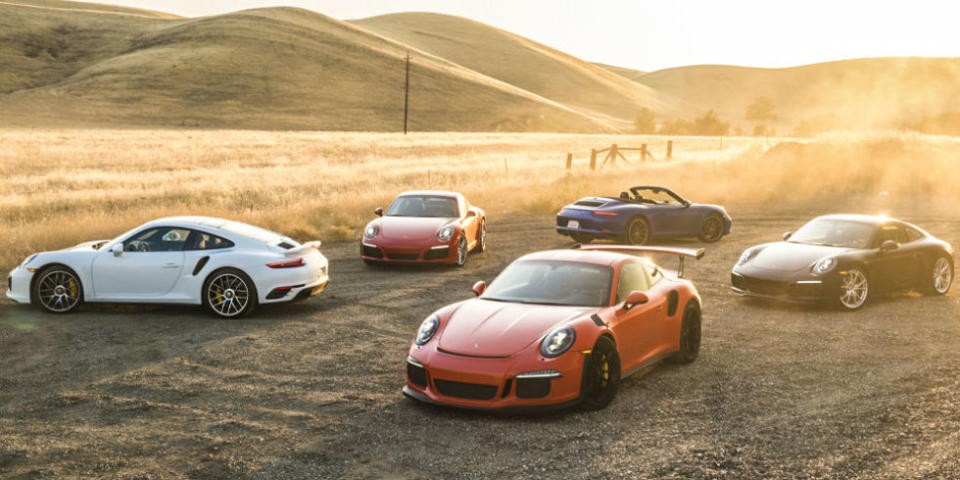
Last summer, we put together a test examining the current state of the Porsche 911. It took place in Northern California, using both public roads and the 2.0-mile "west course" at Thunderhill Raceway Park. Since that test was meant more as an overview-a broad look at the 911 model range-we asked editor at large and club racer Sam Smith for his track notes: What the cars ask of you on a closed course. How they feel, what they want, and most of all, how they're different.
Smith turned in a lot of words, which, if you've ever met Smith, makes perfect sense. He has a hard time shutting up. We let him go on, because really, it's 911s. -Ed.
2017 911 Carrera (991.2)

3.0-liter, twin-turbo H-6. 370 hp @ 6500 rpm, 331 lb-ft from 1700–5000 rpm, Yokohama Advan Sport V105s, open differential, 7-speed manual, 3229 pounds and $97,010 as tested.
The cheap one! That's what we kept calling it. Ha! Sort of. Base price on a non-S 911 Carrera is now just over $90,000. Cheap if you're pricing space programs or principalities, I guess. A Z51-pack Corvette comes in a whopping $30,000 less. It delivers most of what this car does. Maybe it's more entertaining to whale on, maybe not. (Spoiler: Sam likes the Corvette better. Spoiler part two: Sam would take a 997 over either, if we're talking modernish cars. Spoiler part three: Sam really wants a 934 and a Lotus Evora and a hey okay a Cosworth BDA in a dogbone Escort, if you're asking.)
But that's comparison-test think. No matter what anyone says, you don't buy a 911 if you're considering a Corvette, and vice versa. If you want a German thing with this silhouette and that crazy raspy snotty noise and you think you can swing the payments, you want a Carrera. You want what it says about you, represents, does. Maybe you also want to hang out in the dealer's swag area during service appointments, because seriously, who doesn't love $35 branded coffee mugs?
For this test, we asked Porsche for a stripper. A car with few options. They gave us this red Carrera. The only thing I missed was a limited-slip. Half because the car doesn't slide on the throttle as easily without one, half because you occasionally want the traction in tight, cambered corners. Not always, just occasionally. It makes the car snap-to a bit more.
In this company, the Carrera is soft and kind of rolly-the body moves a lot, and you have to manage that. Think fat guy on a bicycle: If you aren't bang on top of weight transfer, you'll know it quickly, but fix it slowly. The car wants one thing and has gentle reflexes. (Gentle for a 991, of course; that's still fast as blazes.) So you dance with it. Buttery control transfers, waiting for shocks to settle. Slow hands always, because quick ones just spike-load the tire before the car's mass has had a chance to catch up.
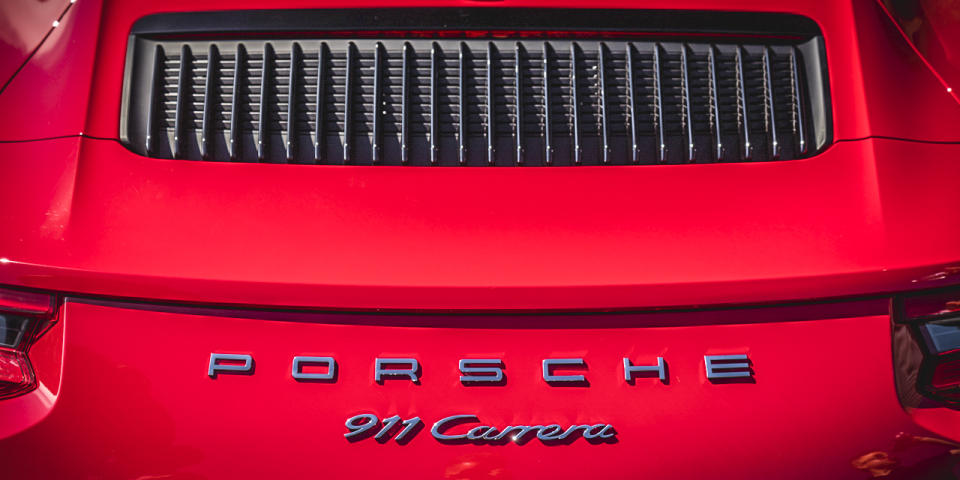
This is supposed to be the purest, simplest 911 you can buy. As such, it's a reminder of two things: One, 991-chassis 911s still don't have much to say in the steering department. It varies with tire brand, but generally, the car's tiller is kind of slick and cold. Porsche is widely regarded as making some of the best electric power steering in the business, and the 911, with its light nose and happy geometry, is the best of their work. But it's still not the way it used to be.
And second, good lord, wheelbase and suspension evolution have done wonders for grip. Old 911s, you have to watch the front tires like a hawk. Too much leaning on them too soon, the car won't turn. The base 991 is forgiving. The nose goes mostly when you want. Not quite as neutral or grippy as the S, but you don't have to drive it as much like a 911 of old. (Short version of that long story: You can be less careful.) This was true for the 991.1, and it's true for the 991.2. My friend Jason Cammisa, now of Motor Trend but once with R&T, always said that the 991 marked the car's transition from sports car to supercar. From a machine where feedback is king to numbers ruling everything. He wasn't wrong.
Out of the whole test, five 911s, this was the only car with a clutch pedal. More people buy automatics, even in 911s. At a track, climbing into a three-pedal car, you forget how much time it takes to change gear. Tenths of seconds, not much, but you notice it here, notice the greater space between control inputs. Even a quick blip and throwing the lever and just railing back into the power-it's all time. Slower than clicking a paddle.
First lap out, somewhere around the second corner, that clutch pedal felt weird. Two seconds later, I realized that was stupid, because this was more interesting. More engaging. It took more work. Manuals wake you up to something. It's a weird song-and-dance, a kind of coming home. One more thing in your control, one more thing to get wrong. Which means that it matters, when you get it right. Because life isn't a qualifying run at Monaco, and I'm not a paid pro driver, which means tenths only count so much.
Short of the RS, this is the car here that I'd take home. Numbers are great, but they're not the only thing.
TL; DR: Enjoy the little things.
2017 911 Turbo S (991.2)
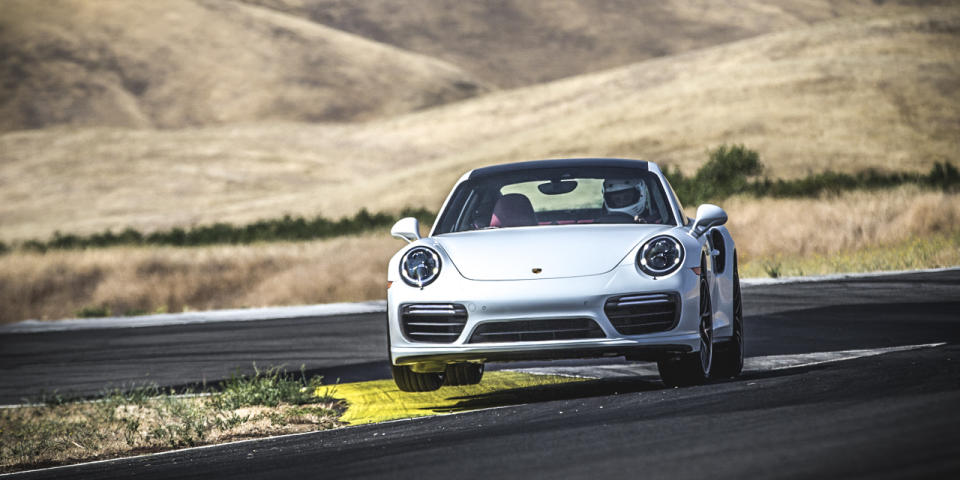
3.8-liter, twin-turbo H-6. 580 hp @ 6750 rpm, 516 lb-ft from 2100–4250 rpm (553 lb-ft at overboost), standard rear-wheel steering, Pirelli P Zeros, electronically controlled limited-slip rear differential, 7-speed dual-clutch automatic, 3563 pounds and $197,745 as tested. All-wheel drive.
This is the magic trick. Interesting beast. Big, fast, heavy, fast, heavy. And heavy? And fast. Did I say heavy? And beast?
It turns like bejesus in the middle of a corner. Thunderhill has an off-camber, uphill left. Third gear in most cars. You go back to the throttle even though you know you shouldn't, and you crank in more steering, just to watch the car understeer. To prove to yourself that it understeers in these circumstances, because most cars understeer here. And because you remember how 911 Turbos behave. (Testing cars isn't just driving around in circles; you verify things. Science!)
Brief digression: In car writing, understeer is a nothing word. Too often used improperly, because it's easy to identify-you turn the wheel, the front tires gibber a little, the car goes more straight than you want it to. Some cars understeer from the factory. It's what happens when you chuck a Nineties Camry into an on-ramp and mat the throttle-front wheels slide, the car widening its arc, not revectoring with steering input. But it's also what happens when you do the wrong thing in a neutral-handling car. A bad driver can make a car understeer. So can road geometry, slick pavement, a weak shock, a locked diff, improper tire pressure. Wearing dirty underwear on a Tuesday. A lot of stuff.
The corner I mentioned lives at Thunderhill. It tends to make cars understeer. 911s are known for entry understeer if driven improperly. Water-cooled (read: modern) 911 Turbos are all-wheel drive, which means they generally have more weight on the front axle, and a more complex system of results when you pick up the gas. This results is gentle understeer more often than not. (In the rain, it's understeer-oversteer-big-slappy-grin. On dirt, it's spooky-fun grip and you're watching the nose again, trying to keep weight on it. I said it varies, right?) In the 991.1 Turbo, it was an odd kind of stable neutrality. Fast but not always entertaining.
In the middle of that Thunderhill corner, weight is already on the back tires. The pavement is working to take away grip, and the nose is jacked up in the air. Road camber wants the car to push to the outside of the pavement. Throttle is just going to transfer even more weight off the nose. So you bleed it in, with a little extra steering, expecting the car to go wide.
Only it doesn't happen. And maybe, if you are me, you do a kind of double-take, glancing at the apex, followed by profanity.
Obnoxious profanity. Something about a cow and maybe also your seventh-grade teacher.
Because that porky robot mother turns.
Not like you'd expect. It's this thing where you put the car in and the car wakes up and realizes you've given it the wrong thing. It just starts following your commands. You can pivot the Turbo S under load at times when you shouldn't be able to-just magic-shuffle-torque-froofy-math. Plus that ridiculous engine, which has just enough lag to feel turbocharged but not so much that it gets in the way. Fast corners are a little more stable-and occasionally looser-than you first think. When the car slides, the rear wheels help you. Stay in the throttle, you get to be the one-handed hero dicking with the radio while warping space-time with yaw on the taillights.
Porky fat robot mother genius.
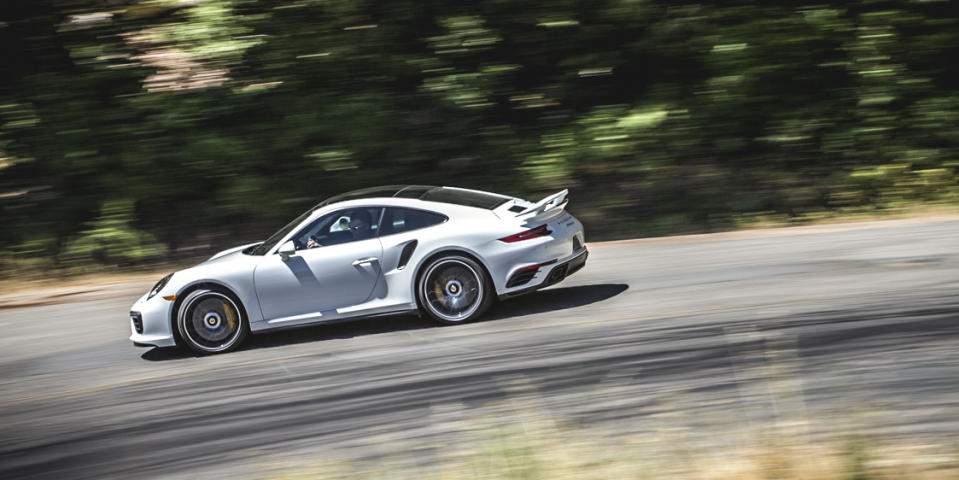
This is what happens when you mix torque-vectoring and locking differentials, computer-controlled all-wheel drive, massive power and torque, and the engineering might of a company that has spent the past decade and a half making SUVs not feel like masochistic tubs. The last 991 Turbo had four-wheel steering. Those cars were good, but they felt distant, weird, a little numb. This one, the steering software and hardware has been evolved, for both axles. A handful of drivetrain updates mean the thing reacts quicker, smarter, has more to say through the wheel. It moves more under throttle and makes you look better than you really are.
In the 991.1, if you screwed up, you had to wait for the car to come back to you. Now you just turn the wheel more and bleed in throttle and the car adjusts its position on the track, even while sliding. It's like, "Huh. Well, OK, here. Is that what you want?"
What do you do in a supercar that does half the work for you? You still have to steer and modulate the throttle. You still need a modicum of experience in getting a car around a race track without hanging the rear bumper on the fence. But the Turbo S is a weird one: It waters down your mistakes. It narrows the delta between a lap full of mistakes and a perfect one. Maybe that's good. Maybe that's bad. The raw speed is fun, for the first few laps. Then you start parsing how the car's covering for you. Purposely doing things wrong just to watch what happens.
Several laps or sessions later, you have a handle on that. You know your faults, and the car's magic tricks have lost their novelty. The fast way around is to be patient with the nose and resist the urge to let the differentials and rear-steer fix your problems. Just drive it like any other 911, plus the monster-put-down-traction-rock-and-roll thing.
I'm not a fan of this thing, personally. I see why people buy it, but the questions it asks of you aren't ones where I care about the answer. The car is fast but distant, communicative only on relative terms. And the relationship always feels one-sided. Compared to the best 911s-telegraphic, talkative wonders-the car is leading the charge. Not you.
TL;DR: Come with stones. And when you find yaw at big speed, just keep your foot in it and believe in the silicon.
911 Carrera S Cabriolet (991.2)

3.0-liter, twin-turbo H-6. 420 hp @ 6500 rpm, 368 lb-ft from 1700–5000 rpm, Pirelli P Zeros, electronically controlled limited-slip differential, 7-speed dual-clutch automatic, 3514 pounds and $144,805 as tested. Rear-wheel drive.
Notes from my first lap in the C2S cab: "Who in their right mind tracks a C2S cab? Bathtub. Bathtub without a roof on it. Bathtub without a roof on it with surprisingly good steering and little cowl shake but good lord seriously all I can think is that I put this thing on its roof and I'm getting a mouthful of dirt."
Weird situation. Can't imagine it's common. Someone out there-someone who does not work at Porsche-has tracked a Carrera S cab that they personally own. That person is very strange. Not wrong, necessarily. Just odd. Perhaps they collect sweaters and read a lot of Joyce. Perhaps they do a lot of coke and wear power ties while mansplaining to their secretary how important it is for the world to go back to the gold standard, and also that men's hair cream should leave the hair shiny and smooth, like a helmet. I have no idea; all I know is that car-owner stereotypes exist for a reason. And that they're occasionally true.
A Carrera S drives like a base Carrera, with a shade more turbo lag in the midrange and down low. The limited-slip helps, as does sharper damping and more roll bar and spring. But in cab form, a track feels like a marketing exercise. I kept wanting to drop the top and blast obnoxious music, because really, why else would you run around in a 911 cab?
More front grip and more rear traction than the base Carrera; this is likely thanks to wider tires (245s and 305s, front and rear, versus 235s and 295s) and the diff. You can pick up the throttle earlier and the additional torque gives a little more flexibility when adjusting the car's attitude. The S-model chassis changes mean the car reacts quicker to weight transfer and input. It feels more focused, even given the flex and mass added by the folding roof.
Plus, it sounds better. Engine wails and sucks into the air, which is right behind your head. Even with the top up, it's louder. So there's that. If you can hate on that, go take a nap.
I found myself wanting the cab's engine and suspension in the base Carrera. Which, thankfully, Porsche will sell you. Thoughtful of them, really.
TL;DR: Buy some hair product with legitimate hold, for those 150-mph-wind days.
911 Carrera 4S (991.2)
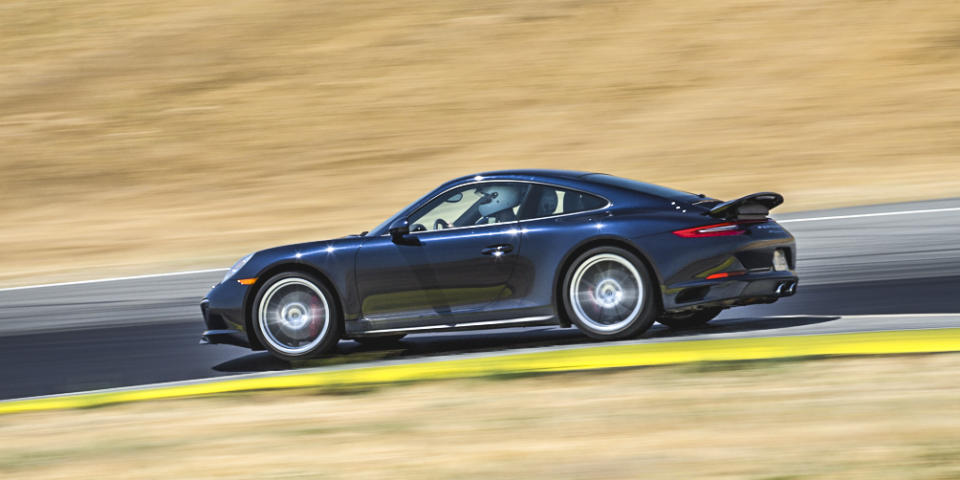
3.0-liter, twin-turbo H-6. 420 hp @ 6500 rpm, 368 lb-ft from 1700–5000 rpm, Pirelli P Zeros, electronically controlled limited-slip differential, 7-speed dual-clutch automatic, 3514 pounds and $142,255 as tested. All-wheel drive.
Imagine the Turbo S without the absurd power. For the most part, that's this. Same basic car, just no atomic boom-boom. Engine from the Carrera S.
Next to the base Carrera, you notice the weight on the front tires. There's a diff and halfshafts up there; even if you discount the benefits of the car's all-wheel-drive system, the mass seems to make a difference in transitions. And the steering is a little fuzzier.
This is an oddly special spec. Not exactly a firecracker, but interesting. All-wheel-drive, non-Turbo 911s have traditionally been heavy and compromised. The 964, 993, 996, and 997 C4S were. I never drove a 991.1 C4S, but people I trust say that a few driveline changes-specifically the optional rear steering and a shift from electromechanical differential control to electrohydraulic, as on the 991.2 Turbo-leave this car feeling sharper. Quicker to shuffle torque. The car slides, but next to the Turbo, you spend more time with your foot matted, more time focused on maintaining momentum. It's more forgiving and tolerant. The steering resembles that of the Turbo S, which is to say, not as talkative as that of the base Carrera. There's some of the Turbo S magic-that steer-it-and-stab juju that lets you paint over mistakes-but the torque deficit makes the C4S a little more interesting.
It also might be the most surprising car in this group, in terms of entertainment factor.
If you discount the GT3 RS.
God, who in blazes would discount the GT3 RS?
TL;DR: Don't park the car in winter. Or spring. Or summer or fall. Basically, don't ever park it. Find mountains and inhale them. Find race tracks and figure out how to slide the car in the dry on a big lift. Learn to mind the front tires. Buy a ski rack.
911 GT3 RS (991.1)
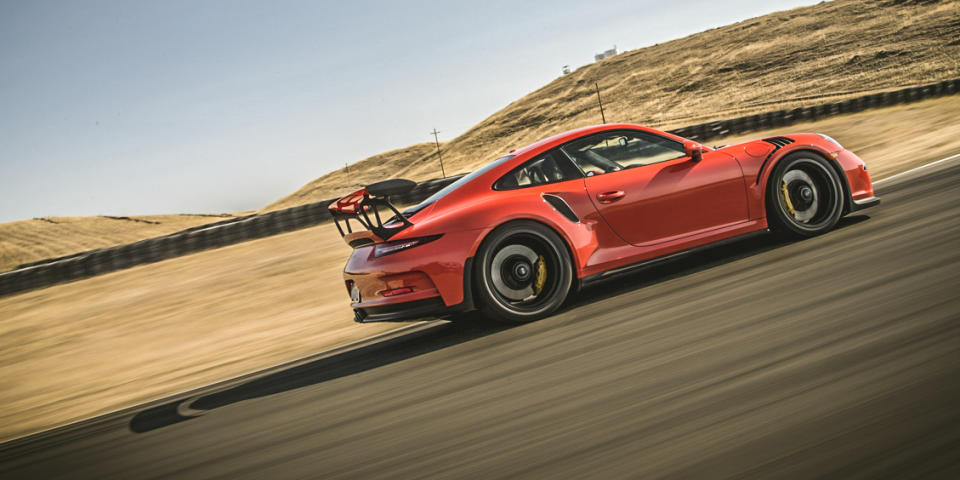
4.0-liter H-6. 500 hp @ 8250 rpm, 338 lb-ft @ 6250 rpm, Michelin Pilot Sport Cup 2s, electronically controlled limited-slip differential, 7-speed dual-clutch automatic, 3292 pounds and $204,460 as tested. Rear-wheel drive.
This is a complex car. No, more accurate: a complex car emulating a simple one. For just under $200,000, Porsche gives you a road-legal machine that does a passable impression of a 911 GT3 Cup car. What does that mean? It means you have little window for error. It means you get a noise that screams (literally; on a track, without earplugs, it's actually painful) RSR at Le Mans. It means you get a magnesium roof because, Porsche says, a carbon-fiber roof done to production standards would actually be heavier. It is the GT3 but lighter, stiffer, louder, more sharply dampened, more aero grip, more focus. Minus sound deadening, a back seat, and a pretense of practicality.
Make no mistake: I am biased. I love this car. I am in love with this car. It is the only machine in this test that truly behaves like an old 911, but it is no more concerned with the past than you are with the hamburger you ate last week. It demands that you be awake, present, engaged, aware of your talent and its limitations. It talks, it takes your mistakes and throws them in your face. No forgiveness, just catching a blip of a slide with quick hands and the car rolling its eyes. And you sitting there, thinking, don't do that again.
This is what modern fast cars should feel like: Look back, then look forward, and keep trying new things. Remember that sensation and fun are half the reason we bother buckling in.
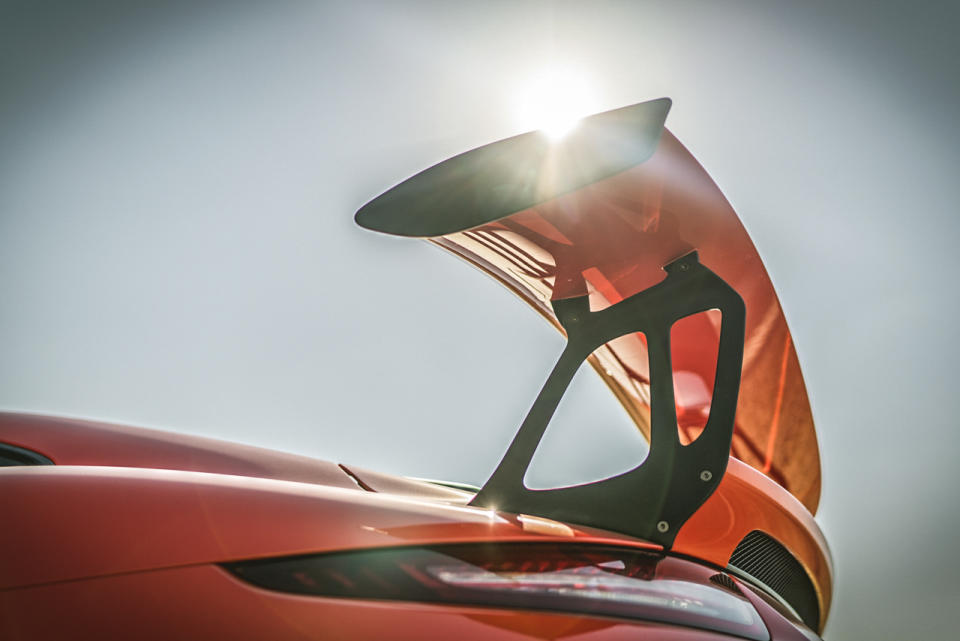
The engine is a stone-cold ripper. It is the same basic six as in the ordinary GT3, a 9A1, massaged and woken, with more torque, more power, a shorter final drive. In a GT3, the engine seems weak-kneed, all top end; you have to rev that car. You have to rev the RS, too, but the additional torque and gearing makes the difference between a fast car and balls-out madness.
I don't remember the GT3's steering being this nice, either. Maybe it's my imagination, maybe it's the RS's standard Pilot Sport Cup 2s, maybe it's the different alignment and lower ride height next to a GT3. Who knows. Half of any electric-power-steering setup is software; maybe they just cued up a smarter tune for the thing, because it's an RS. It's irrelevant. The wheel feels old-911, granular, talkative, real.
The exhaust noise is Star Wars speeder whoop. Like a Cup car, but better. This long, howly climb and then it bangs into gear: Barooowwww. And the tach goes on forever, the car pulling and pulling. The lack of sound deadening means you hear shaft rattle at idle, but also every pebble and rock and bug that hits the underside of the car. It's a hollow rattle box with carpet and an engine. The gearbox slams into upshifts and will grab rubber at highway speed on cold tires, but like every other PDK automatic in every other Porsche, downshifts are a buttery dance. The needle just blip-hops around the tach, a kind of seamless Fred Astaire glissade. With yowl. It's both at odds with the RS's personality and completely at home with it.
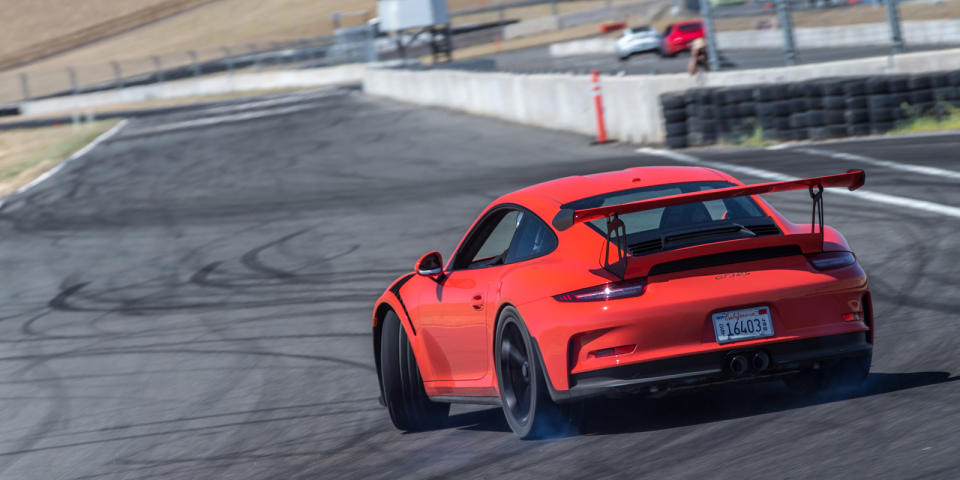
Great brake feel. The best of the cars in this test, though the Turbo S comes close. A hard pedal that takes big effort but is somehow simultaneously modulateable with a toe. Plus what must be one of the most transparent ABS systems in the business. On public roads, you get standard supercar: little roll and enough mechanical grip that you can't lean on the tires without generating absurd, perhaps irresponsible speed. But it's coupled with enough spring rate, and firm enough damping, that the window for screwups becomes narrow. (If you can drift an RS on a public road at speed and stay in your lane, I salute you.) Brilliant, compliant dampers and a butter-smooth locking diff make you think you're better than you are.
The car feels undertired, but only on a race track. Only when the tires get hot, and only because it has 500 damn horsepower being shuttled through two wheels. If I were a professional racer, I would want more tire in it. Because I am a nerd who loves to slide things, I don't. And most of all, unlike any of the 911s here, the RS is sensitive to how you come off the brakes. It wants a quick, smooth roll-not a pop, not even a hint of one, or the car's nose comes up. It takes effort and patience-lap-time clock ticking away-to get it back down. (Goodbye, any semblance of workable front downforce; goodbye, happy front tires; goodbye, car that points cleanly.) You have to physically, actively work the car down to an apex, just like an old 911. Just like most modern cars have worked to make you forget.
I've driven a lot of supercars, a lot of cars with big spring rate and aero, a lot of purpose-built race cars. A Group C car, multiple open-wheelers. Both 996 and 997 GT3 RSs. This is different-a weird, happy middle ground between pro-car simulacrum and usable road car. It recalibrates your brain clinically, in a way that other supercars don't, because other supercars feel like . . . supercars. Which is to say ordinary, or at least to a template. This is something different. This is a proper device, steeped in history. It takes work to build up to, work to enjoy, work to appreciate.
Hallelujah.
TL;DR: Drink your damn coffee and wear the big-boy pants.
You Might Also Like

 Yahoo Autos
Yahoo Autos 